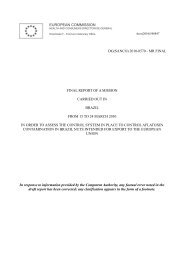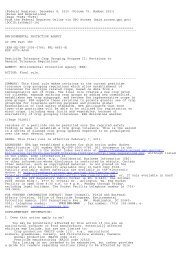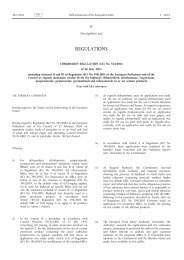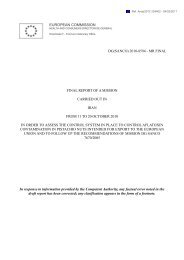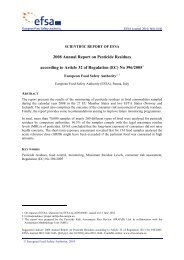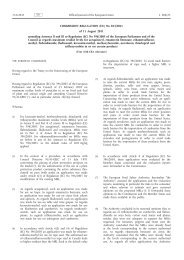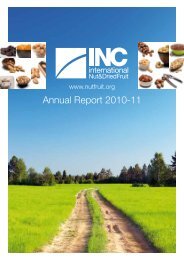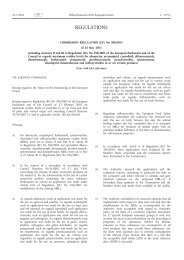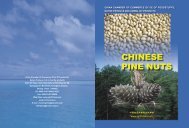2011 Codex Committee on Contaminants in Foods - Institute of Food ...
2011 Codex Committee on Contaminants in Foods - Institute of Food ...
2011 Codex Committee on Contaminants in Foods - Institute of Food ...
- No tags were found...
Create successful ePaper yourself
Turn your PDF publications into a flip-book with our unique Google optimized e-Paper software.
REP11/CF 8c<strong>on</strong>siderati<strong>on</strong> by the next sessi<strong>on</strong> <strong>of</strong> the <str<strong>on</strong>g>Committee</str<strong>on</strong>g>.EDITORIAL AMENDMENTS TO THE GSCTFF (Agenda Item 8) 1251. The <str<strong>on</strong>g>Committee</str<strong>on</strong>g> agreed to discuss this Agenda Item at the next sessi<strong>on</strong> as there was nodocument available at this sessi<strong>on</strong>.DISCUSSION PAPER ON MYCOTOXINS IN SORGHUM (Agenda Item 9a) 1352. The Delegati<strong>on</strong> <strong>of</strong> Sudan, as the Chair <strong>of</strong> the electr<strong>on</strong>ic Work<strong>in</strong>g Group (e-WG) <strong>on</strong>Mycotox<strong>in</strong>s <strong>in</strong> Sorghum, <strong>in</strong>troduced the report <strong>of</strong> the work<strong>in</strong>g group, as presented <strong>in</strong> CX/CF 11/5/9.53. It was reported that records and <strong>in</strong>formati<strong>on</strong> <strong>on</strong> the occurrence <strong>of</strong> mycotox<strong>in</strong>s <strong>in</strong> gra<strong>in</strong>sorghum was <strong>in</strong>complete. However, available <strong>in</strong>formati<strong>on</strong> showed that 9 mycotox<strong>in</strong> types <strong>in</strong> 12countries were reported <strong>on</strong> sorghum. The ma<strong>in</strong> toxigenic fungi <strong>in</strong> sorghum were found to beAspergillus flavus, A. parasiticus, A. ochraceus, Alternaria alternata, Claviceps africana, Fusariumverticilliodes, F. proliferatum, F. gram<strong>in</strong>earum and F. semitectum, and aflatox<strong>in</strong>s were the mostresearched mycotox<strong>in</strong>s <strong>in</strong> sorghum. Other types <strong>of</strong> mycotox<strong>in</strong>s <strong>in</strong>clud<strong>in</strong>g fum<strong>on</strong>is<strong>in</strong>s, ochratox<strong>in</strong>s,zearalen<strong>on</strong>e, trichothecenes, deoxynivalenol, nivalenol and ergos<strong>in</strong>e were also reported <strong>in</strong> sorghum <strong>in</strong>some countries.54. The <str<strong>on</strong>g>Committee</str<strong>on</strong>g> noted that the electr<strong>on</strong>ic Work<strong>in</strong>g Group made recommendati<strong>on</strong>s whichc<strong>on</strong>cerned two po<strong>in</strong>ts: (i) more collecti<strong>on</strong> <strong>of</strong> data and research to be d<strong>on</strong>e <strong>on</strong> the occurrence <strong>of</strong>mycotox<strong>in</strong>s <strong>in</strong> sorghum; and (ii) the development <strong>of</strong> a Code <strong>of</strong> Practice (COP) for the management <strong>of</strong>aflatox<strong>in</strong>s <strong>in</strong> sorghum as an additi<strong>on</strong>al annex to the exist<strong>in</strong>g Code <strong>of</strong> Practice for the Preventi<strong>on</strong> andReducti<strong>on</strong> <strong>of</strong> Mycotox<strong>in</strong> C<strong>on</strong>tam<strong>in</strong>ati<strong>on</strong> <strong>in</strong> Cereals (CAC/RCP 51-2003).55. Not<strong>in</strong>g that sorghum was the fifth largest cereal <strong>in</strong> the world with an annual producti<strong>on</strong> <strong>of</strong> 65milli<strong>on</strong> t<strong>on</strong>s and c<strong>on</strong>sumed as a staple crop for many African populati<strong>on</strong> groups, the <str<strong>on</strong>g>Committee</str<strong>on</strong>g>supported the recommendati<strong>on</strong>s proposed by the e-WG to update the discussi<strong>on</strong> paper to explore thefeasibility <strong>of</strong> <strong>in</strong>clud<strong>in</strong>g an additi<strong>on</strong>al annex <strong>in</strong> the exist<strong>in</strong>g COP, while countries c<strong>on</strong>t<strong>in</strong>ue collecti<strong>on</strong> <strong>of</strong>data <strong>on</strong> the occurrence <strong>of</strong> mycotox<strong>in</strong>s <strong>in</strong> sorghum and sorghum-based food products at the pre- andpost-harvest levels as well as data <strong>on</strong> dietary <strong>in</strong>take especially from major produc<strong>in</strong>g countries. The<str<strong>on</strong>g>Committee</str<strong>on</strong>g> c<strong>on</strong>sidered that it was important to update data especially from major sorghum produc<strong>in</strong>gcountries.56. The Representative <strong>of</strong> WHO <strong>in</strong>formed the <str<strong>on</strong>g>Committee</str<strong>on</strong>g> that follow<strong>in</strong>g the previous discussi<strong>on</strong>s<strong>in</strong> the <str<strong>on</strong>g>Committee</str<strong>on</strong>g> <strong>on</strong> the lack <strong>of</strong> data <strong>on</strong> mycotox<strong>in</strong>s <strong>in</strong> sorghum, sufficient fund<strong>in</strong>g had been securedthrough the <str<strong>on</strong>g>Codex</str<strong>on</strong>g> Trust Fund to enable FAO and WHO to jo<strong>in</strong>tly implement a project cover<strong>in</strong>g 4pilot countries <strong>in</strong> Africa to collect samples, possibly from 2 harvests, and analyse mycotox<strong>in</strong>s andmycotox<strong>in</strong>-produc<strong>in</strong>g fungi <strong>in</strong> sorghum. The project will start <strong>in</strong> <str<strong>on</strong>g>2011</str<strong>on</strong>g> and run for 3 years and will, tothe extent possible, also gather <strong>in</strong>formati<strong>on</strong>, <strong>on</strong> agricultural practices related to the sorghumproducti<strong>on</strong> <strong>in</strong> these countries.57. A delegati<strong>on</strong> stressed that develop<strong>in</strong>g a COP for sorghum was very relevant to its country asthe majority <strong>of</strong> the populati<strong>on</strong> c<strong>on</strong>sumed sorghum as a ma<strong>in</strong> cereal and po<strong>in</strong>ted out that the smallscalesubsistence farm<strong>in</strong>g practices <strong>of</strong> sorghum should be taken <strong>in</strong>to account to ensure that thesefarmers could comply with the COP.C<strong>on</strong>clusi<strong>on</strong>58. The <str<strong>on</strong>g>Committee</str<strong>on</strong>g> agreed to re-establish the electr<strong>on</strong>ic Work<strong>in</strong>g Group, under the chairmanship<strong>of</strong> Nigeria, work<strong>in</strong>g <strong>in</strong> English <strong>on</strong>ly and open to all <str<strong>on</strong>g>Codex</str<strong>on</strong>g> members and observers, to update thediscussi<strong>on</strong> paper to screen the general part <strong>of</strong> the exit<strong>in</strong>g Code <strong>of</strong> Practice for the Preventi<strong>on</strong> andReducti<strong>on</strong> <strong>of</strong> Mycotox<strong>in</strong> C<strong>on</strong>tam<strong>in</strong>ati<strong>on</strong> <strong>in</strong> Cereals (CAC/RCP 51-2003) to ascerta<strong>in</strong> whether it wasrelevant and feasible for the producti<strong>on</strong> <strong>of</strong> sorghum and to explore the feasibility <strong>of</strong> <strong>in</strong>clud<strong>in</strong>g an1213CX/CF 11/5/8 (not available).CX/CF 11/5/9; CRD 3 (comments <strong>of</strong> Kenya); CRD 4 (comments <strong>of</strong> Mali); CRD 7 (comments <strong>of</strong> theEuropean Uni<strong>on</strong>); CRD 9 (comments <strong>of</strong> Thailand); CRD 12 (comments <strong>of</strong> Tanzania); CRD 13(comments <strong>of</strong> Ind<strong>on</strong>esia); CRD 16 (comments <strong>of</strong> Nigeria); and CRD 17 (comments <strong>of</strong> Camero<strong>on</strong>).



